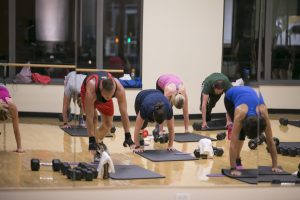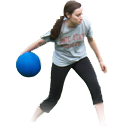
Moving Beyond Your Daily Exercise
Exercise. Seemingly, you do everything right. Eat sensibly and reach the American Heart Association’s recommended 75 minutes of vigorous exercise and 150 minutes of moderate exercise each week. But what about those other 9,855 minutes? After eight hours of sleep, we are still left with 7,755 waking minutes.
It is increasingly possible to navigate life without ever moving. This disturbing reality whacked me over the head when I heard my two-year-old nephew bossing Google around. “Hey Google, play Sesame Street.”
We can now ask Alexa to deliver what once merited a trip to the grocery store. Last Christmas, rather than plugging in the Christmas tree each night, I stepped on a button on the floor. As harmless as that sounds, we may soon lose the ability to descend to the floor to reach for an awkward plug. Life has grown so convenient as to never require more than a few simple movements. Varied, creative movement is essential to our physical, mental, and emotional health. When we allow our bodies to atrophy to the point that we can no longer experience the joy of movement, we lose the foundation of our wellbeing.
How Bad Is It?
The problem is only getting worse. A 2015 study sampled over 2,500 teens and found that they averaged almost nine hours on “entertainment media” each day, excluding time spent at school and doing homework. For most students, this fills every non-school hour. Worse, the school day is basically seven hours of sitting, broken by a few brief walks to their next assigned chair.
This problem follows us into adulthood. Nielson Research found that adults spent 63% more time on their smartphone in 2017 than in 2015. As Senator Ben Sasse remarks in his book, The Vanishing American Adult, we are consumed by “social affluence that allows us to entertain ourselves to death.”
Does This Really Matter If You Are Working Out?
The short answer is yes! Citing a study from the National Institute of Health, a New York Times survey found that: “It doesn’t matter if you go running every morning, or you’re a regular at the gym. If you spend most of the rest of the day sitting—in your car, your office chair, on your sofa at home—you are putting yourself at increased risk of obesity, diabetes, heart disease, a variety of cancers and an early death.
When we sit, the breakdown of fats and sugars stalls and our body down-regulates. According to Mayo Clinic cardiologist Martha Grogan, “For people who sit most of the day, their risk of heart attack is about the same as smoking.”
Sitting invites lethargy and brain fog.
For many, this malaise has become the default state. We have become content to work out for an hour a day, only to sit and stare at a computer for the next eight hours. Then we sit in a car for the drive home, sit and eat dinner, and sit and watch TV before heading to bed. After the work week, we may even reward ourselves with a full day on the couch binging Netflix or watching sports. A sedentary weekend is far more common than one filled with play and physical activity.
Exercise is often a Band-aid applied to a gaping wound: a life devoid of human movement. While an improvement, exercise alone is not sufficient. As the age of automation prepares to rev into overdrive, it is increasingly important to examine our environments to intentionally integrate consistent movement.
Creating Opportunities to Move
We must understand frequent movement is essential for cognitive, emotional, and physical wellbeing. We must create structures to promote movement. Perhaps we break our workday every few hours for two to four minutes of exercise. Other methods include:
- Take the stairs.
- Get a standing desk. These can be inexpensive.
- Have walking meetings.
- Drink a lot of water. You’ll have to get up and go!
- Get a dog that needs a walk twice a day.
- Sit on the floor to read, work, and watch TV. You will need to constantly re-adjust and move.
- Bike to work.
- Park in the furthest possible parking spot.
- Create no-phone zones and screen-based technology boundaries. An object at rest tends to stay at rest. Falling into the phone trap less frequently can only help.
Move, Even When It Means Swimming Upstream
You would love to move more at work, but feel stuck in meetings, cubicles, commutes, and other ever-present societal expectations to sit. Every modern social gathering feature two things: enough junk food to feed a small nation, and an abundance of chairs. I invite you to shrug off this pressure, get creative, and risk being weird. Max Shank inspired me to stretch between flights. I will offend no one by stretching, but I felt deeply uncomfortable at first. If expressing a desire to move after many hours confined on a flight makes you the weird one, embrace it.
Still, many work environments make it very tough to move. This is the final frontier that we as a society must address. As the diseases of seated affluence proliferate, we must address the chair-strapped workplace environment. Encouraging movement can benefit an employer’s bottom line through increased productivity. Workers who use sit-stand workstations “unanimously claim to be more alert, task-driven, and positive.”
Schools are the most important area to address
Students now grow up conditioned to seek sedentary entertainment, even as their mental, emotional, and physical health grow epidemically poor. The CDC reports that over 30% of children between ages 2 and 19 are now overweight or obese. Rather than addressing rampant childhood obesity and the habits that create it, we’ve de-emphasized physical education, as 96% of elementary schools no longer offer P.E. 4 Rather than prioritize human thriving, we compel our youth to sit through a broad and superficial education, instead of immersive, experiential human development.
Do not throw up your hands, concluding that the world has gone to hell in a handbasket. We must implore those in authority in our businesses and schools to alter the environment. In the meantime, we can each take responsibility for ourselves as individuals. Your actions can influence others more than you know. Live the solution to create the momentum of change.
The Arena District Athletic Club is more than just a gym, it’s a premier fitness facility located in the heart of the Arena District in downtown Columbus. We provide convenience and quality, featuring top-of-the-line equipment, top-notch personal trainers, spa-like locker rooms and a wide variety of free group fitness classes daily including Cardio, Spinning, Barre Fusion, Yoga, Boot Camp and more. We offer free 2-hour parking and convenient contract-free memberships, to fit your healthy lifestyle needs. Don’t just join, belong.





